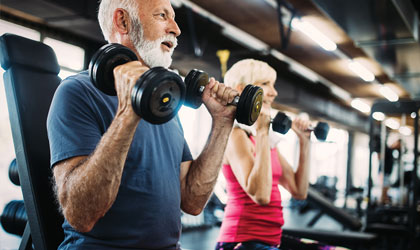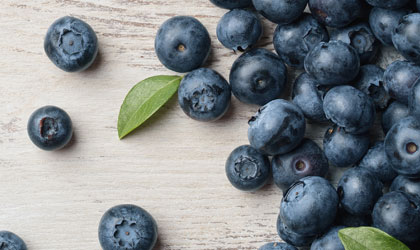
Starving yourself skinny and knocking back the tipples might have been all the rage when you were young, but these excesses of youth will certainly take their toll on your bones in later life and can cause them to weaken. You see, far from being an inert ‘skeleton in the closet’, bones are constantly changing and adapting to the way you live your life – nothing escapes them. The good news, however, is that even if you were a wild child in your former days, you still have time to improve your bone health with these simple lifestyle changes.
What happens to bones as you age?
In the same way skin wrinkles and eyesight wanes, bones age overtime. From the age of 40, peak bone mass begins to decline for both men and women. Unfortunately for women, the menopause accelerates the waning of bones thanks to the absence of oestrogen, which is a key bone-bolstering hormone (discover more about how to maintain bone health after the menopause here). Up until this point, the body is continuously eliminating old bone and replacing it with new bone – a process called ‘resorption’. Once you hit 40, however, less bone is replenished. And that’s why bone health must take pride of place at this stage of your life.
How to support bone health after 40?
Stay active
When the big ‘4 0’ comes round, you need to make physical activity an integral part of your bone building toolbox. Like muscles, bones also get stronger with exercise. Being inactive will only increase the likelihood of falls, fractures, and weak bones. While flexibility and strength training are important areas to focus on, too (learn more about exercising for bone health here), weight-bearing exercise is the numero uno for bone health. Jogging, walking, hiking, tennis, and stair climbing are stellar options in your arsenal since they aid the production of calcium deposits and osteoblasts – cells that stimulate bone growth. To build happy, healthy bones, aim for two, 30-45 minutes, sessions of weight-bearing exercise every week. For those over 65, the NHS recommends performing 150 minutes of moderate intensity exercise, in 10-minute sessions or more, every weeki. Moderate activity will increase your heart rate, make you feel warmer, and breathe faster. Top tip: you should still be able to hold a conversation when you’re working out at a moderate level.
Prone to bone fractures? Weight-bearing exercise is still crucial. Moving your body will improve countless areas of health: balance, stamina and confidence. Ceasing to move entirely won’t do your bones (or the rest of your body) any favours. Naturally, though, there are some caveats you should be wary of: avoid high impact activity that involves running, bending forwards, and jumping. Steer clear of tennis, golf, and some yoga poses, too. Instead, go for Nordic walking, low impact aerobics, or low impact dance classes. It may sound hackneyed, but the phrase ‘move it or lose it’ really rings true as you enter your golden years.
Bone up with calcium
Let’s be honest: when you think bones, you think calcium. And as you age, this well-worn cliché is more pertinent than ever. Besides being a building block of your skeleton, this mineral is required for nearly every operation in the body, including nerve and muscle function, and blood clotting. Trouble is, if your calcium stores run dry, your body will greedily leach it from your bones, making them weak, porous, brittle, and prone to breakages. The secret to getting your calcium fix is thinking beyond traditional dairy. Yes – there’s more to calcium than guzzling milk and chowing down on cheese! You can find an abundance of calcium in other nutrient-dense foods: canned fish, figs, nuts, seeds, tofu, and fortified foods. To nourish your bones, aim for at least 700mg every day.
Let the sunshine in
Contrary to public thought, bone nutrition doesn’t end with calcium; you also need adequate amounts of vitamin D to support the skeletal system in your later years. These bone-health powerhouses are quite the team: calcium bolsters and maintains bone density, while vitamin D aids with the absorption of calcium. Simply put, your intake of calcium and vitamin D must be sufficient enough to fully realise the benefit of each nutrient on your bones. Vitamin D isn’t called the ‘sunshine nutrient’ for nothing. The best way to get your daily dose of vitamin D is with 15 minutes of unprotected, directed sunlight. Winter? No problem. Make a conscious effort to fill up on vitamin D-rich foods, such as oily fish (salmon, mackerel, and tuna), cheese, mushrooms, egg yolks, and other fortified foods. Alternatively, you could follow the advice of Public Health England and add a vitamin D supplement to your dietii. Look for a formula that packs at least 10mcg.
Cram in vitamin K2
Despite being a little more under-the-radar, vitamin K2 is another crucial nutrient for bone health as you age. Amongst some of its most impressive bone health credentials, this nutrient supports the balance of calcium in your body, plays a significant role in bone formation, and strives to protect against fractures. Fermented foods, ripe cheese, and yoghurt are the richest sources of vitamin K2. As a rule of thumb, adults need 1mcg (microgram) of vitamin K2 for every kilogram of body weight daily. So, if you weigh 75kg, you would need 75mcg.
Eat your veggies
‘Eat your veggies!’ It’s advice we hear time and again – and for good reason. Amongst myriad health benefits, these fellas are chock-full of bone-bolstering nutrients, like magnesium and vitamin C. While magnesium supports the proper absorption and utilisation of calcium, vitamin C aids with the production of collagen – a main component of your bone structure. In a three-month study, women who consumed more than nine servings of veggies saw a significant decrease in bone turnover (the amount of bone that’s resorbed and formed over a period of time)iii. If nine servings sound unrealistic to you, aim for five to seven every day. Top tip: dark leafy greens, like kale, spinach, and Swiss chard, deliver some of the tastiest bone-building magnesium and vitamin C.
Go easy on the tipples
Beyond affecting your heart and liver, your bones don’t take too kindly to going OTT on the tipples. You see, drinking to excess skews the delicate balance of calcium in the body, which is needed to bolster and sustain healthy bones. Worse still, alcohol abuse can interfere with the production of vitamin D – yet another critical bone-bolstering nutrient that aids with the absorption of calcium. In one analysis, researchers found that women, aged between 67 and 90, who drank more than six drinks per day, had greater bone loss than their female counterparts who drank prudentlyiv. To keep the health risks associated with alcohol to a minimum, drink no more than 14 units a week, and be sure to spread your drinking over 3 or more days. Moving forward, why not use smaller glasses for your tipples so you aren’t lured into drinking more? Learn more about the effect of alcohol on bone health here.
Yes, you can be too thin
Magazines, TV adverts, and Instagram posts may sell ‘thinness’ as a one-way ticket to happiness, but dropping into a calorie deficit will only threaten to hijack your bone health. Though piling on the pounds won’t do your bones any favours, either, dramatic weight loss will compromise your bones the most. Want an excuse to ditch a diet of salad leaves and detox tea? Listen up. A growing raft of evidence has revealed that regimens delivering less than 1,000 calories a day may cause significant bone loss in normal-weight, overweight, and obese individualsv. You see, if you’re underweight, it’s possible that you’re not consuming a healthy, balanced diet, which can result in your body lacking the nutrients it needs to work optimally. Calcium, for instance, is vital for the maintenance of strong bones; failure to get enough can lead to weakened bones. As you age, then, make a conscious effort to eat a varied and colourful diet that delivers at least 1,500 calories every day.
Kick butts
Want another reason to stub out smoking for good? Science continuously points to cigarette smoke leading to a higher risk of bone fractures, compromised bone mass, a decrease in new bone formationvi. In a landmark study, researchers proposed one in 8 hip fractures may result from cigarette smokevii. All things considered, it really is one of the worst vices for your bones. Kicking this fiercely addictive habit isn’t always easy, so be sure to get all the help you need to quit. Learn more about the effects of smoking on bone health here.
References:
-
NHS.UK. (2019). Keep your bones strong over 65. Available online: https://www.nhs.uk/live-well/healthy-body/keep-your-bones-strong-over-65 [22 Apr. 2019].
-
GOV.UK. (2019). PHE publishes new advice on vitamin D. Available online: https://www.gov.uk/government/news/phe-publishes-new-advice-on-vitamin-d [Accessed 22 Apr. 2019].
-
Gunn. C., Weber. J., McGill. A. & Kruger. M. (2015). Increased Intake of Selected Vegetables, Herbs and Fruit may Reduce Bone Turnover in Post-Menopausal Women. Nutrients. ;7(4), 2499-2517.
-
Hannan. M., Felson. D., Dawson-Hughes. B., Tucker. K., Cupples. L., Wilson. P. & Kiel. D. (2010). Risk Factors for Longitudinal Bone Loss in Elderly Men and Women: The Framingham Osteoporosis Study. Journal of Bone and Mineral Research. ;15(4), 710-720.
-
Redman. L. (2008). Calorie Restriction and Bone Health in Young, Overweight Individuals. Archives of Internal Medicine. ;168(17), 1859. Villareal. D., Fontana. L., Das. S., Redman. L., Smith. S., Saltzman. E., Bales. C., Rochon. J., Pieper. C., Huang. M., Lewis. M. & Schwartz. A.(2015). Effect of Two-Year Caloric Restriction on Bone Metabolism and Bone Mineral Density in Non-Obese Younger Adults: A Randomized Clinical Trial. Journal of Bone and Mineral Research. ;31(1), 40-51.
-
Al-Bashaireh. A., Haddad. L., Weaver. M., Chengguo. X., Kelly. D. & Yoon. S. (2018). The Effect of Tobacco Smoking on Bone Mass: An Overview of Pathophysiologic Mechanisms. Journal of Osteoporosis. ;1-17.
-
Law. M.R., Hackshaw. A.K. (1997). A meta-analysis of cigarette smoking, bone mineral density and risk of hip fracture: recognition of a major effect. BMJ. ;315:841-6.
You Might Also Like

Olivia
Olivia Salter has always been an avid health nut. After graduating from the University of Bristol, she began working for a nutritional consultancy where she discovered her passion for all things wellness-related. There, she executed much of the company’s content marketing strategy and found her niche in health writing, publishing articles in Women’s Health, Mind Body Green, Thrive and Psychologies.
View More



